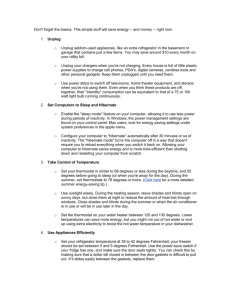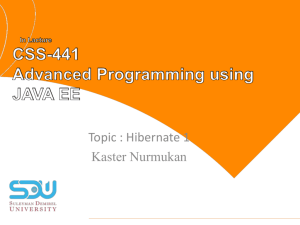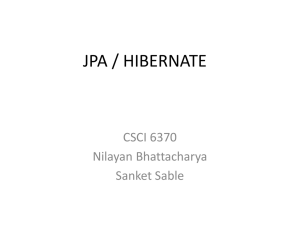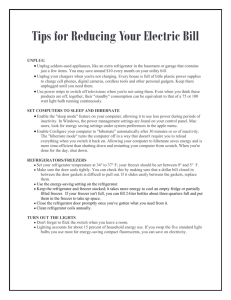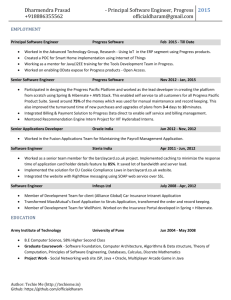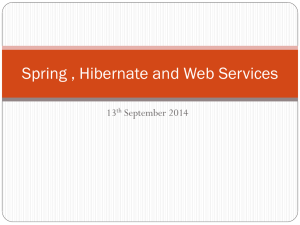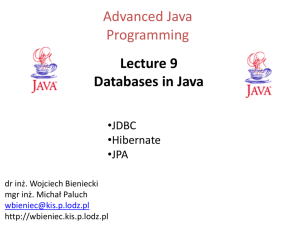JDBC
advertisement
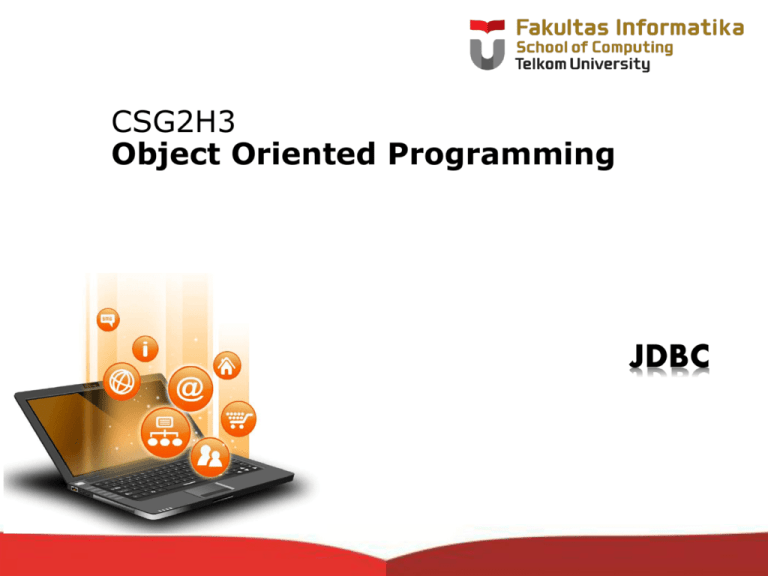
CSG2H3 Object Oriented Programming JDBC Java Database Connectivity An API that lets you access virtually any tabular data source from the Java programming language an interface which allows Java code to execute SQL statements inside relational databases – the databases must follow the ANSI SQL-2 standard General Architecture Database Programming Steps Establish a connection Begin transaction Create a statement object Associate SQL with the statement object Provide values for statement parameters Execute the statement object Process the results End transaction Release resources Using JDBC Load the driver: – The driver class libraries need to be in the CLASSPATH for the Java compiler and for the Java virtual machine. – The most reliable way to load the driver into the program is: Class.forName(string).newInstance(); Using JDBC Establish a connection to the database: – A connection URL string includes the literal jdbc:, followed by the name of the driver and a URL to the database String url = "jdbc:oracle:thin:@reddwarf.cs.rit.edu:1521:csodb"; – Create a Connection object: Connection con = DriverManager.getConnection(url, dbUser, dbPassword Using JDBC Begin the transaction – con.setTransactionIsolation(connection.TRANSACTION_SE RIALIZABLE ); – con.setAutoCommit( false ); Create a statement object – Statement stmt = conn.createStatement(); Associate SQL with the statement object – String queryString = "create table students " + "(name varchar(30), id int, phone char(9))"; Using JDBC Process the statement: – Example statements: ResultSet int rs = stmt.executeQuery(querystring); result = stmt.executeUpdate(updatestring); ResultSetMetaData rsMeta = rs.getMetaData(); – Compiled queries can be processed via a PreparedStatement object – Stored procedures can be processed via a CallableStatement object Using JDBC End transaction – con.commit(); – con.rollback(); Release resources – con.close(); Question? CSG2H3 Object Oriented Programming Hibernate ORM Traditional vs object-oriented application RDBMS vs OODBMS Relational databases store data in tables that are two dimensional. – The tables have rows and columns. Relational database tables are "normalized" – data is not repeated more often than necessary. All table columns depend on a primary key (a unique value in the column) to identify the column. – Once the specific column is identified, data from one or more rows associated with that column may be obtained or changed. Hibernate ORM an object-relational mapping framework for the Java language, providing a framework for mapping an object-oriented domain model to a traditional relational database. Hibernate solves object-relational impedance mismatch problems by replacing direct persistence-related database accesses with highlevel object handling functions. Simple Tutorial Hibernate ORM In this example we use : – NetBeans IDE 8.0.1 – Java 1.8 – Hibernate 4.3 – MySQL Class Model 1. Create Database 1 1. Open services tab 2. Right-click at MySQL Server 2 – Create Database 3. Name the database 3 4. Click ok 4 2. Connect to the Database 1. Right-click at database – click Connect 2. Look at the connection created 3. Create Hibernate Configuration 1. File -> New File 2. Select categories : Hibernate 3. Select Hibernate Configuration Wizard 4. Next 2 3 3. Create Hibernate Configuration5 5. Don’t change the name and location – Click Next 6. Select the database connection 7. Finish 6 4. Create Hibernate Mapping 1. File -> New File 3 2. Select categories : Hibernate 3. Select Hibernate Mapping Wizard 4. Next 2 4. Create Hibernate Mapping 5 5. Rename the name – student.hbm 6. next 6 4. Create Hibernate Mapping 7 7. Select Student class in “Class to Map” column – Click “…” to browse 8. Finish 9. Do the same for class Teacher and Classroom 8 5. Modify the mapping .xml Map object Student to table tbStudent Map object Teacher to table tbTeacher Map object Classroom to table tbClassroom – Map attribute teacher as a foreign key many-to-one to table tbteacher – Map attribute list student as foreign key one-to-many to table tbstudent 5a. student.hbm.xml 5b. teacher.hbm.xml 5c. classroom.hbm.xml 6. Create Hibernate Util class 1. File -> New File 2. Select categories : Hibernate 3. Select HibernateUtil.java 4. Next 3 2 7. Modify the HibernateUtil.java 8. Modify the hibernate.cfg.xml Make sure the mapping xml is properly listed As you can see in source mode 8. Modify the hibernate.cfg.xml Add connection information to your database – Add your username and password for database You might also add additional information 9. Application Class 9. Application Class openConnection() – closeConnection() 9. Application Class – saveObject( o : Object ) 9. Application Class – loadAll() 9. Application Class – updateObject( o : Object ) 9. Application Class – deleteObject( o : Object ) 9. Application Class – getClassroom() getStudent() getTeacher() Good to read http://hibernate.org/ http://docs.jboss.org/hibernate/orm/4.3/manual/ en-US/html/ http://www.tutorialspoint.com/hibernate/ THANK YOU Credits Music : Yonezawa Madoka - Oui! Ai Kotoba (Instrumental)
